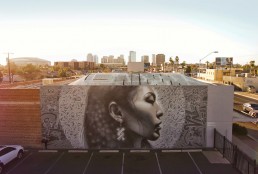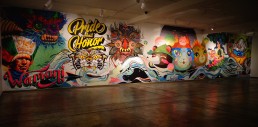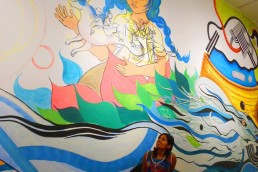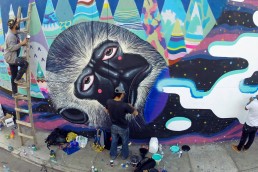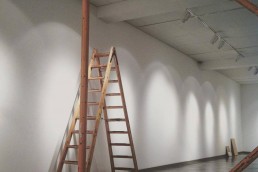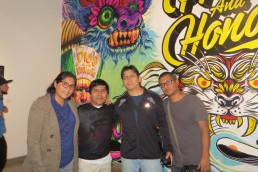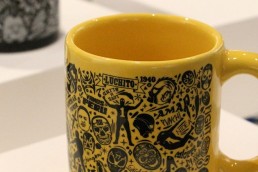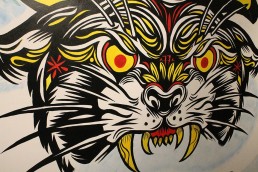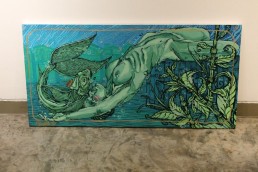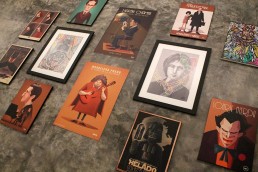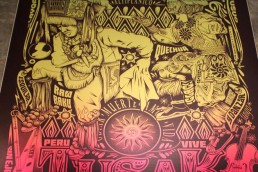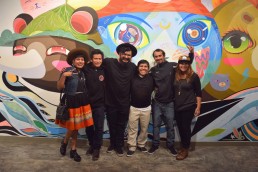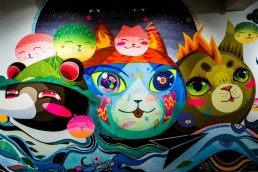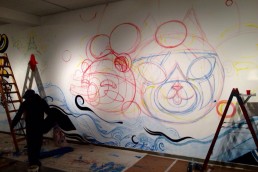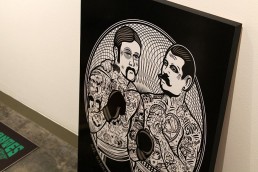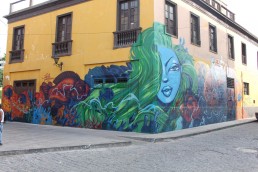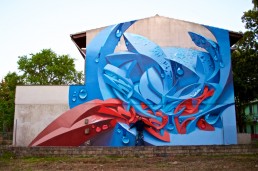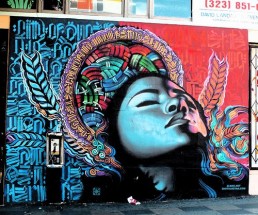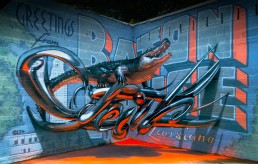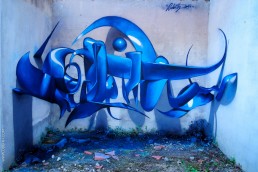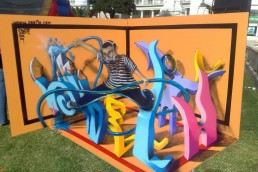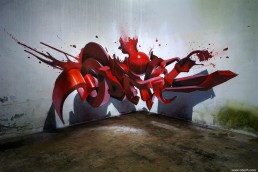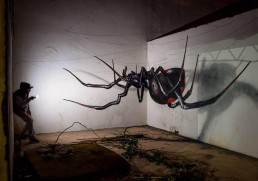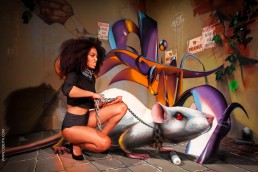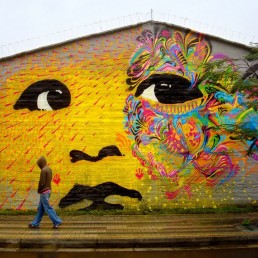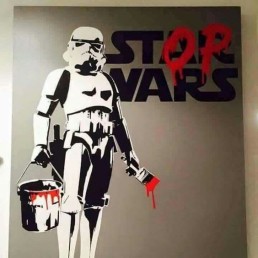ELMAC
No, no se trata de esa marca de preciosos y sobrevalorados ordenadores...
Elmac es un artista del spray. Uno de los nuevos dioses nacidos del polvo de las calles, criado en un desierto.
Otro genio q pasa desapercibido para los grandes medios, y circuitos del trasnochado arte moderno, pero q a pesar de todo va haciéndose un hueco.
Cuando inicialmente vi sus obras en Pinterest, q por cierto tiene más de museo q El Prado o el "Gugengein" como sea q se escriba, pensé por sus mujeres aparentemente de rasgos latinos y belleza abrumadora que debía ser mexicano. Pues México es un hervidero cultural y sus obras parecían elogios a la belleza chicana (esto para mí es no es nada despectivo, todo lo contrario). Y no solo hablo de mujeres jóvenes, ya que tiene muchas obras de personas de toda edad con dichos rasgos étnicos.
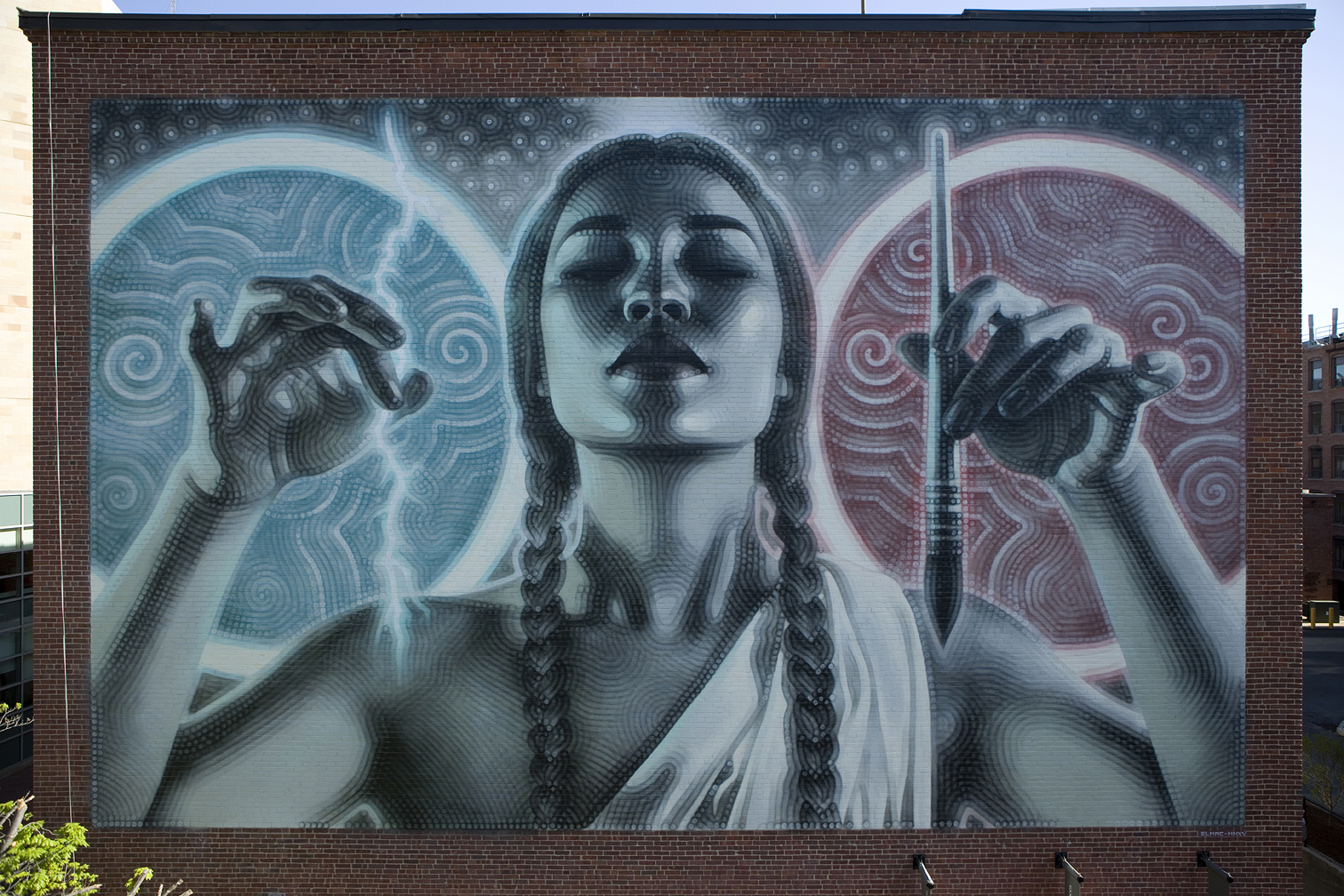
Esa serenidad q logra en sus retratos, sus flores en el pelo, planos contrapicados, y las pasadas de aerosol que van dando volumen me parecieron asombrosas.

Mucho tiempo que quedé satisfecho sin necesitar saber más de él, sus obras hablan de sobra.
Pero ahora tras investigar un poco, lo encuentro haciendo graffitis en Marruecos. De un Touareg, otro de su gato... Y en las fotos no parece mexicano.
Más bien gringo, como dirían los latinos. De hecho escribe en inglés. Eso es lo de menos, lo veo pintando tb en algunos museos norteamericanos, universidades... parece que no para. Me alegro mucho por él.

Realiza además cuadros en acrílico con unos trazos espectaculares, q al menos a mí me sugieren culturas precolombinas pero parecen fruto de su descomposión del dibujo en luces y sombras... admirables.

Intentaremos contactar con él yaveriguaré más cosas para contaros, lo prometo.
Alguna de sus bellezas parece ser tailandesa... eso para empezar, al final ambas comparten un origen asiático al menos en parte.
Aquí va su web:
http://elmac.net

Perú la potencia oculta
Latinoamérica aún esconde muchos de sus secretos. Pero aún lastrados por el subdesarrollo fruto de sus gobernantes egoistas e ineptos, lucha por surgir la Cultura Popular y demostrar su desbordante riqueza. Atentos al Nuevo Perú. El de la calle y sus creadores.
Muestra Gráfica Urbanaen ICPNA Perú
Destacados artistas jóvenes vinculados a expresiones estéticas presentan diversos trabajos, desde el graffiti hasta el diseño de tipografía o, incluso, otros oficios como la técnica del estampado en tela, pasando por el mural callejero con tintes académicos o el arte del stencil. La curaduría está a cargo de Jaime Higa y Rafael Llimós.
Diez creadores y dos colectivos de arte urbano participan de esta exposición que estará abierta al público desde el 12 de agosto en la Galería Juan Pardo Heeren (Jr. Cuzco 446). Posteriormente habrá una visita guiada el martes 25 de agosto a las 7 p.m. El horario de visita a la sala es de martes a domingo de 11 a.m. a 8 p.m.
En “Gráfica urbana” se presentan dos vías estéticas: “Por un lado, la propuesta basada en signos y estilos que tienen como referentes a esta actualidad globalizada, enmarcada bajo la estética visual de las actuales ciudades, donde los letreros luminosos y los edificios con fachadas de cristal son los mayores protagonistas. Por otro lado, la corriente que ha surgido como una respuesta a lo global, suscrita a referentes y/o gustos nacionales en el marco de las estéticas populares, como la llamada chicha. Estas dos propuestas estéticas separadas por un límite difuso se juntan en la mayoría de casos como ejemplo de la cultura de masas, desde lo global, pero con ciertos rasgos locales” explican los curadores de la muestra.
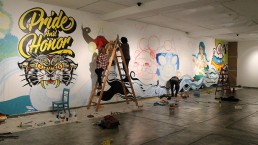
Expresión totalde Arte liberador
El proyecto acoge tanto a grupos como artistas individuales, con diferentes recorridos en la práctica artística, pero vinculados por la calle como espacio de trabajo. Participan con sus trabajos: Ale Wendorff, Cristhian Hova, Colectivo Brochagorda, Diego Rossell, Elian Tuya, Jaime Higa, Lici Ramírez, Los Salvajes, Mucho, Orlando Aquije, Portocarrero 3Y y Samuel Gutiérrez.
Es dentro de la sala que los artistas muestran además un gran mural intervenido por ellos.
Participantes:
Ale Wendorff
Artista plástica autodidacta. Ha participado en distintas exposiciones indiviuales y colectivas en el Perú y el extranjero y festivales de arte urbano.
Cristhian Hova
Egresado de la carrera de Publicidad en la Universidad Inca Garcilaso de la Vega (2011), diseñador gráfico digital y trabajador independiente, brinda servicios de ilustración en distintas agencias de publicidad.
Colectivo Brochagorda
Conformado por Cindy Mescco y Gonzalo Leandro, artistas plásticos que además se desempeñan como ilustradores y muralistas. Se inició con el propósito de difundir nuevos códigos dentro de la temática popular por medio de un arte con forma y contenido que reivindique dicho concepto.
Diego Rossell
Arquitecto y artista visual autodidacta, productor constante de proyectos de intervención urbana desde 2010. Premio de Mejor Documental Nacional de la Fundación Telefónica ETECOM 2012 “Espacios Extraviados” (Intervención Urbana).
Elian Tuya
Ilustradora con estudios en SENATI. Desde 2013 vive en México. Ha estado en varias expo-ferias de ilustración. Entre sus intereses artísticos figuran: la música, la psicodelia, lo kitsch, la cultura Remix y la ironía.
Jaime Higa
Ha estudiado en la Facultad de Arte de la PUC y en la Escuela de Bellas Artes Corriente Alterna. Ha realizado 15 muestras individuales en Perú y EE.UU. Actualmente se desempeña como director de Bruno Gallery y organiza muestras colectivas.
Lici Ramírez
Estudió en la Escuela Nacional de Bellas Artes y egresó el año 2006 con la Medalla de Oro en la especialidad de grabado. Como artista plástica recientemente ha realizado dos muestra individuales: “Corazón de Retablo” (2012) y “Grabado en la Piel” (2014), también ha expuesto su obra en diversas colectivas en el país y el extranjero.
Los Salvajes
Colectivo de arte urbano integrado por Nemo, Peremese y Jimbo, quienes pintan animales humanizados en convivencia y armonía con la naturaleza. Desde su taller en el centro de Lima, planean próximas intervenciones y realización de talleres.
Mucho
Estudió diseño gráfico en el Instituto San Ignacio de Loyola. Tiene en su haber dos muestras individuales y varias colectivas. Es un incansable participante y organizador de exposiciones y eventos relacionados con el muralismo y el graffiti.
Orlando Aquije
Diseñador y artista gráfico. Ha colaborado en publicaciones como Caretas, Etiqueta Negra; con las editoriales españolas Santillana y Anaya, y además ha participado en diversas exposiciones colectivas. Es creador de la marca de arte gráfico “Atix” junto a Keila Muñoz Llosa. Desde 2014 es parte del colectivo Los Únicos.
Portocarrero 3Y
Estudia actualmente en la Escuela de Bellas Artes de Lima. Cuenta con una exposición individual y ha participado activamente en muestras colectivas relacionadas con el muralismo, así como en diversas ferias artísticas.
Samuel Gutiérrez
Diseñador de interiores profesional y diseñador gráfico por vocación. Desde el populoso distrito de San Juan de Lurigancho muestra una gráfica que refleja la realidad nacional y la mixtura de costumbres costeñas, serranas y selváticas. Grafismo, producción gráfica y textil, muralismo ystreet art son los campos que suele explorar su trabajo.
Más información► http://ow.ly/QubFu
Arte Urbano en Casa Colonial Lima
Many years ago, I worked for my parents who own a video production company. Because it is a family business, you inevitably end up wearing many hats and being the czar of many different jobs. I mainly managed projects and worked as a video editor. On production, there were times that I was called on to work as an audio tech and was made to wear headphones on long production days. In those days, having a really good set of headphones that picked up every nuance of sound was essential to making sure the client got what they needed.
First impressions.
Naturally, my first impression of these headphones is based off of the look of them. They have a classic over-the-ear style that is highlighted by a blue LED light that indicates the power for the noise canceling. The padding on the ear pieces seems adequate for extended usage periods.
They are wired headphones, but the 3.5mm stereo mini-plug cable is detachable. Something else I noticed right of the bat was the very nice carrying case that comes with them. It has a hard plastic exterior with a soft cloth interior that helps to protect the surface of the headphones from scratches. I never truly appreciated cases for headphones until I started carrying them from place-to-place. Now I can’t imagine not having a case.
A perfect fit.
Once I gave the headphones a thorough once-over exam, I tried them on. As I mentioned, they have a classic over-the-ear style and just looking at them, the padding on the ear pieces seem adequate and the peak of the headband seemed to be a bit lacking, but you don’t really know comfort unless you try on the product. So, I slipped the headphones on and found them to be exquisitely comfortable.
Quality.
Now that I had the headphones on my head, I was finally ready to plug and play some music. I plugged the provided cable into the jack on the headphones and then the one on my iPhone 6. Then I called up Pandora. I tend to have a very eclectic music purview and have many stations set up for different moods. From John Williams to Fallout Boy, the sound quality of these headphones was remarkable. There is an amazing depth of sound and incredible highs and lows that make listening to music a truly breathtaking experience.
It’s safe to say that because of my unique professional experiences, I’ve tested out a lot of headphones.
In order to test how voices sounded, and the overall art of sound mixing, I pulled up Netflix on my iPad Air 2 and watched a few minutes of a movie to hear all the nuances of the film. None of them were lost. In fact, I ended up hearing sounds that I hadn’t heard before. Echoes…birds chirping…wind blowing through trees…breathing of the characters…it was very impressive what the headphones ended up bringing out for me.
I would highly recommend these to any sound mixing specialist.
Peeta: Graffiti 3D
Graffitis con volumen
Si se trata de crear un texto que se salga literalmente de la pared Peeta es el indicado.
Hoy día es uno de los mayores exponentes del llamado Graffiti con letras en 3D (model pastel).
Sus graffitis engañan al ojo haciéndole creer que sale de la pared con un volumen q parece real.
Este artista veneciano, que además es escultor nos ofrece un trabajo sorprendente y que despierta la imaginación. Alejado del graffiti clásico, el aire fresco siempre viene bien.
La técnica para lograrlo requiere bastante esfuerzo y cuantos más colores tenga más difícil se hace lograr el efecto.
Libera tu mente.
Sumérjete en sus formas y perspectivas que parecen transportarte a un mundo futuro.
Palabras eu fluyen sobre paredes en un idioma aprendido de la calle. Donde el estilo tradicional ha evolucionado y tomado vida, ritmo visual creado por formas cónicas, cilíndricas y superficies que se retuercen.
Toma contacto con las leyes de la luz y la sobra para entender y reproducir un mundo siempre asombroso.
Artículo en proceso
Sumérjete en sus formas y perspectivas que parecen transportarte a un mundo futuro.
Palabras eu fluyen sobre paredes en un idioma aprendido de la calle. Donde el estilo tradicional ha evolucionado y tomado vida, ritmo visual creado por formas cónicas, cilíndricas y superficies que se retuercen.
Toma contacto con las leyes de la luz y la sobra para entender y reproducir un mundo siempre asombroso.
Peeta, también conocido como Manuel Di Rita, enfoca su trabajo según sus palabras en revelar la decepción de la percepción humana. La falacia de los puntos de vista fijos y estrechos, fácilmente manipulables con trucos visuales.
Make it clean and simple
Create your header preset in just few clicks.
Just the other day I happened to wake up early. That is unusual for an engineering student. After a long time I could witness the sunrise. I could feel the sun rays falling on my body. Usual morning is followed by hustle to make it to college on time. This morning was just another morning yet seemed different.
Witnessing calm and quiet atmosphere, clear and fresh air seemed like a miracle to me. I wanted this time to last longer since I was not sure if I would be able to witness it again, knowing my habit of succumbing to schedule. There was this unusual serenity that comforted my mind. It dawned on me, how distant I had been from nature. Standing near the compound’s gate, feeling the moistness that the air carried, I thought about my life so far.
This is what has happened to us. We want the things we have been doing forcefully to fail. And then maybe people around us would let us try something else or our dreams. We are accustomed to live by everyone else’s definition of success. We punish people for the things they are passionate about, just because we were unable to do the same at some point in our life.
I was good at academics, so decisions of my life had been pretty simple and straight. Being pretty confident I would make it to the best junior college of my town in the first round itself, never made me consider any other option. I loved psychology since childhood, but engineering was the safest option. Being born in a middle class family, thinking of risking your career to make it to medical field was not sane. I grew up hearing ‘Only doctor’s children can afford that field’ and finally ended up believing it. No one around me believed in taking risks. Everyone worshiped security. I grew up doing the same.
Control fonts, background, size, parallax and overlay...
‘Being in the top will only grant you a good life’ has been the mantra of my life. But at times, I wish I was an average student. I wish decisions would have not been so straightforward. Maybe I would have played cricket- the only thing I feel passionate about. Or maybe I would have studied literature (literature drives me crazy). Isn’t that disappointing- me wishing to be bad at academics. It’s like at times I hate myself for the stuff I am good at.
I feel like these concrete buildings have sucked our desires and our dreams. We are so used to comfort that compromise seems like a taboo. We have lost faith in ourselves. If we can make through it right now, we can do the same in the days to come. You only need a desire to survive and nothing more- not money or cars or designer clothes.
Staying locked up in four walls have restricted our thinking. I feel like our limited thinking echoes through this wall. We are so used to schedules and predictable life that we have successfully suppressed our creative side.
When you step out of these four walls on a peaceful morning, you realize how much nature has to offer to you. Its boundless. Your thoughts, worries, deadlines won’t resonate here. Everything will flow away along with the wind. And you will realize every answer you had been looking for, was always known to you.
It would mean a lot to me if you recommend this article and help me improve. I would love to know your thoughts!
Odeith Saliendo de la pared
Odeith o como pintar en 3 dimensiones
Si la tecnología aún no ha hecho posible esto que ha perseguido lograr muchos artistas a lo largo del tiempo, la mano humana lo ha logrado simular desde hace mucho.
Una de las técnicas usadas ha sido la pintura anamórfica, más popular por artistas que usan el suelo y tiza para lograr el aspecto de las 3 dimensiones.
Está técnica es la que ha revitalizado y mezclado con el Arte Urbano el portugués Odeith, logrando efectos nunca antes vistos gracias al uso de varias paredes y una técnica de graffiti y mural desbordantes de calidad.
Usando varias paredes logra engañar por completo al ojo humano si la pieza se observa desde un punto concreto.
Generación Banksy
Este artista nacido en Damaia Portugal en 1976 lleva desde los años 90 practicando su arte en su país natal y después de manera internacional.
Así q de edad similar a Banksy, tomó un rumbo completamente distinto pero igualmente hacia la genialidad. En su caso como dice él, dominar las sombras 3D, para lograr ese realismo que le caracteriza y que hace que sus piezas parezcan flotando sobre el muro.
Tras trabajar también en el mundo del tatuaje sigue asombrándonos con sus letras y animales suspendidos en el aire entre las paredes.
Otro genio
Las calles y paredes en las que interviene nunca serán las mismas. La victoria de la imaginación sobre la realidad que nos regala, nos confirma que cada autor tiene que encontrar su estilo propio y cuando se encuentra un camino, seguirlo es fundamental para hacernos creer que la creatividad humana pese a los límites de la física no tiene límites.
Si quieres saber mucho más de él: www.odeith.com
Chequea esto!
Just the other day I happened to wake up early. That is unusual for an engineering student. After a long time I could witness the sunrise. I could feel the sun rays falling on my body. Usual morning is followed by hustle to make it to college on time. This morning was just another morning yet seemed different.
Witnessing calm and quiet atmosphere, clear and fresh air seemed like a miracle to me. I wanted this time to last longer since I was not sure if I would be able to witness it again, knowing my habit of succumbing to schedule. There was this unusual serenity that comforted my mind. It dawned on me, how distant I had been from nature. Standing near the compound’s gate, feeling the moistness that the air carried, I thought about my life so far.
I was good at academics, so decisions of my life had been pretty simple and straight. Being pretty confident I would make it to the best junior college of my town in the first round itself, never made me consider any other option. I loved psychology since childhood, but engineering was the safest option. Being born in a middle class family, thinking of risking your career to make it to medical field was not sane. I grew up hearing ‘Only doctor’s children can afford that field’ and finally ended up believing it. No one around me believed in taking risks. Everyone worshiped security. I grew up doing the same.
This is what has happened to us. We want the things we have been doing forcefully to fail. And then maybe people around us would let us try something else or our dreams. We are accustomed to live by everyone else’s definition of success. We punish people for the things they are passionate about, just because we were unable to do the same at some point in our life.
I feel like these concrete buildings have sucked our desires and our dreams. We are so used to comfort that compromise seems like a taboo. We have lost faith in ourselves. If we can make through it right now, we can do the same in the days to come. You only need a desire to survive and nothing more- not money or cars or designer clothes.
Staying locked up in four walls have restricted our thinking. I feel like our limited thinking echoes through this wall. We are so used to schedules and predictable life that we have successfully suppressed our creative side.
When you step out of these four walls on a peaceful morning, you realize how much nature has to offer to you. Its boundless. Your thoughts, worries, deadlines won’t resonate here. Everything will flow away along with the wind. And you will realize every answer you had been looking for, was always known to you.
It would mean a lot to me if you recommend this article and help me improve. I would love to know your thoughts!
Time is passing by
CSS selectors all exist within the same global scope. Anyone who has worked with CSS long enough has had to come to terms with its aggressively global nature — a model clearly designed in the age of documents, now struggling to offer a sane working environment for today’s modern web applications. Every selector has the potential to have unintended side effects by targeting unwanted elements or clashing with other selectors. More surprisingly, our selectors may even lose out in the global specificity war, ultimately having little or no effect on the page at all.
Any time we make a change to a CSS file, we need to carefully consider the global environment in which our styles will sit. No other front end technology requires so much discipline just to keep the code at a minimum level of maintainability. But it doesn’t have to be this way. It’s time to leave the era of global style sheets behind.
It’s time for local CSS.
In other languages, it’s accepted that modifying the global environment is something to be done rarely, if ever.
In the JavaScript community, thanks to tools like Browserify, Webpack and JSPM, it’s now expected that our code will consist of small modules, each encapsulating their explicit dependencies, exporting a minimal API.
Yet, somehow, CSS still seems to be getting a free pass.
Many of us — myself included, until recently — have been working with CSS so long that we don’t see the lack of local scope as a problem that we can solve without significant help from browser vendors. Even then, we’d still need to wait for the majority of our users to be using a browser with proper Shadow DOM support.
We’ve worked around the issues of global scope with a series of naming conventions like OOCSS, SMACSS, BEM and SUIT, each providing a way for us to avoid naming collisions and emulate sane scoping rules.
We no longer need to add lengthy prefixes to all of our selectors to simulate scoping. More components could define their own foo and bar identifiers which — unlike the traditional global selector model—wouldn’t produce any naming collisions.
import styles from './MyComponent.css';
import React, { Component } from 'react';
export default class MyComponent extends Component {
render() {
return (
<div>
<div className={styles.foo}>Foo</div>
<div className={styles.bar}>Bar</div>
</div>
);
}
The benefits of global CSS — style re-use between components via utility classes, etc. — are still achievable with this model. The key difference is that, just like when we work in other technologies, we need to explicitly import the classes that we depend on. Our code can’t make many, if any, assumptions about the global environment.
Writing maintainable CSS is now encouraged, not by careful adherence to a naming convention, but by style encapsulation during development.
Once you’ve tried working with local CSS, there’s really no going back. Experiencing true local scope in our style sheets — in a way that works across all browsers— is not something to be easily ignored.
Introducing local scope has had a significant ripple effect on how we approach our CSS. Naming conventions, patterns of re-use, and the potential extraction of styles into separate packages are all directly affected by this shift, and we’re only at the beginning of this new era of local CSS.
process.env.NODE_ENV === 'development' ?
'[name]__[local]___[hash:base64:5]' :
'[hash:base64:5]'
)
Understanding the ramifications of this shift is something that we’re still working through. With your valuable input and experimentation, I’m hoping that this is a conversation we can have together as a larger community.
Note: Automatically optimising style re-use between components would be an amazing step forward, but it definitely requires help from people a lot smarter than me.
Esto q sugería Buda hace unos milenios está muy de actualidad.
Ya q una de las formas de control de masas habitual es negar el valor de su cultura e identidad contraponiéndolos con los valores de la clase dominante.
Reconocer el valor de la diversidad y fomentarla hará q todos podamos avanzar derrotando la mediocridad y uniformidad a la q intentan someternos.
Y es q la frase de la Biblia de considerarnos rebaño no es fortuita.
Pero nuestro mamífero antepasado no fue una oveja, mas bien sería similar a una zarigüella.
O hablando llanamente: somos mas similares a las ratas q a las ovejas.
Y para eso está la evolución en marcha, para q si no mejoramos, al menos Cambiemos!
BANKSY el nuevo Lennon
Pocos artistas están consigiendo tanta influencia y reconocimiento como este inglés de identidad secreta cual superheroe de la mordaz crítica social q ejecuta con elegancia total.
Nuestra sociedad se va al carajo y es un fracaso en muchos aspectos, eso está claro. Pero como la mayoría sigue zombie en su fiebre comsumista y absortos en vanalidades, tuvo q llegar él para decirnos q estos tiempos son gilipollescos a mas no poder.
Suena el despertador.
Si Lennon nos puso las cosas claras el siglo pasado cantando sobre las cosas verdaderamente importantes sin artificios ni tonterias, mientras nos ilusionaba con el sí se puede y cómo. Banksy nos pasa revista y sin apenas palabras, nos intenta abrir los ojos sobre lo estúpidos q podemos ser como humanos y como casi sin esperanza hemos perdido el norte.
Sus obras se cotizan imparables.
Eso es cierto, pero como se extrae de su documental, no fue el objetivo q persiguió ni persigue eso hoy día.
Por suerte su trabajo sigue siendo hacernos pensar, sentir de nuevo. Recapacitar. Renacer de nuestra basura de vida q otros han diseñado para nosotros.
Lo mas gracioso es como Banksy llega a donde está ahora. Ya q al parecer no era muy hábil con los sprays y el Arte Urbano lleva su tiempo. A eso se sumó el riesgo siempre presente de q lo detuviera la policia, lo q lo llevó a difundir sus mensajes de la forma q hoy es mas conocido, llevando su plantilla preparada para poner su sello por doquier en pocos segundos. Ese tiempo q pasó escondido debajo de coches por miedo a ser detenido, no deja de ser una paradoja de nuestros días: los artistas se esconden y los ladrones se meten política o campan en total libertad siempre q la suma de lo robado sea muy elevada.
No hizo falta más y hoy tiene su altar.
Quizá él tb consiga q muchos despierten al igual q hizo Lennon. Algo debe tener Inglaterra q siempre produce esta clase de genios
Sus piezas e intervenciones ojalá perduren como aquella dedicada a la reina madre q no era borrada por estar en la valla de un comercio q cerraba tiempo después de la ronda de la policia.
Y es q hoy el arte, se compra, se vende, se comparte y tb en muchas ocasiones Se Borra. Eso dice mucho de nuestras autoridades.

